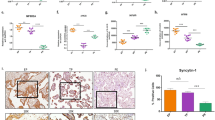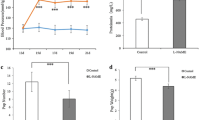Abstract
To explore the possible mechanisms of cadmium (Cd)-induced preeclamptic conditions in rats. In the present study, we introduced the in vivo model of preeclampsia by giving intraperitoneal injections of cadmium chloride (CdCl2) to pregnant rats from gestational day (GD) 4 to 19. Maternal body weights were recorded on GD 0, 14, and 20, while their systolic blood pressures (SBPs) monitored on GD 3, 11, and 18. On GD 20, rats were sacrificed and the specimens were collected. The morphological changes of placenta and kidney tissues of pregnant rats were examined by hematoxylin and eosin staining assay. Blood Cd level was detected by inductively coupled plasma mass spectrometry. Total antioxidant capacity (TAC) was evaluated using FRAP method and total nitrite (NOx) was detected with Griess reagent. Antioxidative factors and DNA damage/repair biomarkers were measured by real-time qPCR, western blot or immunohistochemistry study. The current results showed that CdCl2-treated pregnant rats developed preeclampsia (PE)-like manifestations, such as hypertension, albuminuria, with decreased TAC and increased blood Cd level, and pro-oxidative/antioxidative or DNA damage/repair biomarkers. Our study demonstrated that increased oxidative DNA damage in placenta could contribute to Cd-induced preeclamptic conditions in rat.



Similar content being viewed by others
References
Young BC, Levine RJ, Karumanchi SA (2010) Pathogenesis of preeclampsia. Annu Rev Pathol 5:173–192
Roberts JM, Cooper DW (2001) Pathogenesis and genetics of pre-eclampsia. Lancet 357:53–56
Lucian B, Camelia B, Vasile B, Otilia M, Mariana M (2010) Report on the influence of heavy metals on the evolution of the pregnancy in smoking mothers. Analele Universitătii din Oradea Fascicula: Ecotoxicologie, Zootehnie si Tehnologii de Industrie Alimentară 99–104.
Helmestam M, Stavreus-Evers A, Olovsson M (2010) Cadmium chloride alters mRNA levels of angiogenesis related genes in primary human endometrial endothelial cells grown in vitro. Reprod Toxicol 30:370–376
Ling Y, Ye X, Ji H, Zhang YH, Lai YS, et al (2010) Synthesis and evaluation of nitric oxide-releasing derivatives of farnesylthiosalicylic acid as anti-tumor agents. Bioorg Med Chem 18:3448–3456
Livak KJ, Schmittgen TD (2001) Analysis of relative gene expression data using real-time quantitative PCR and the 2-△△Ct method. Methods 25:402–408
Pistarini C (2013) Oxidative stress in post-acute ischemic stroke patients: relevance of early intensive neurorehabilitation. J Neurol Neurophysiol 4:154
Bartosz G (2003) Total antioxidant capacity. Adv Clin Chem 37:220–292
Mitra E, Ghosh AK, Ghosh D, Mukherjee D, Chattopadhyay A, Dutta S, et al (2012) Protective effect of aqueous curry leaf (Murraya koenigii) extract against cadmium-induced oxidative stress in rat heart. Food Chem Toxicol 50:1340–1353
Nair A, DeGheselle O, Smeets K, Van Kerkhove E, Cuypers A (2013) Cadmium-induced pathologies: where is the oxidative balance lost (or not)? Int J Mol Sci 14:6116–6143
Wang Q, Ning X, Chen L, Pei D, Zhao J, Zhang L, et al (2011) Responses of thioredoxin 1 and thioredoxin-related protein 14 mRNAs to cadmium and copper stresses in venerupis philippinarum. Comp Biochem Physiol C Toxicol Pharmacol 154:154–160
Zhang M, An C, Gao Y, Leak RK, Chen J, Zhang F (2013) Emerging roles of Nrf2 and phase II antioxidant enzymes in neuroprotection. Prog Neurobiol 100:30–47
Mann GE, Niehueser-Saran J, Watson A, Gao L, Ishii T, de Winter P, et al (2007) Nrf2/ARE regulated antioxidant gene expression in endothelial and smooth muscle cells in oxidative stress: implications for atherosclerosis and preeclampsia. Sheng Li Xue Bao 59:117–127
Lin F, Yu X, Zhang X, Guo Y, Huang Y, Zhou J, et al (2013) A synthetic analog of lipoxin A4 partially alleviates dexamethasone-induced fetal growth restriction in rats. Placenta 34:941–948
Storr SJ, Woolston CM, Zhang Y, Martin SG (2013) Redox environment, free radical, and oxidative DNA damage. Antioxid Redox Signal 18:2399–2408
Kasai H (1997) Analysis of a form of oxidative DNA damage, 8-hydroxy-2'-deoxyguanosine, as a marker of cellular oxidative stress during carcinogenesis. Mutat Res Rev Mutat Res 387:147–163
Kelley MR, Georgiadis MM, Fishel ML (2012) APE1/Ref-1 role in redox signaling: translational applications of targeting the redox function of the DNA repair/redox protein APE1/Ref-1. Curr Mol Pharmacol 5:36–53
Ho E, Ames BN (2002) Low intracellular zinc induces oxidative DNA damage, disrupts p53, NF κB, and AP1 DNA binding, and affects DNA repair in a rat glioma cell line. Proc Natl Acad Sci U S A 99:16770–16775
Hossain MZ, Gilbert SF, Patel K, Ghosh S, Bhunia AK, Kern SE (2013) Biological clues to potent DNA-damaging activities in food and flavoring. Food Chem Toxicol 55:557–567
Burton GJ, Jauniaux E (2011) Oxidative stress. Best Pract Res Clin Obstet Gynaecol 25:287–299
Cuypers A, Plusquin M, Remans T, Jozefczak M, Keunen E, Gielen H, et al (2010) Cadmium stress: an oxidative challenge. Biometals 23:927–940
Dai B, Liu T, Zhang B, Zhang X, Wang Z (2013) The polymorphism for endothelial nitric oxide synthase gene, the level of nitric oxide and the risk for pre-eclampsia: a meta-analysis. Gene 519:187–193
Palmer R, Bridge L, Foxwell N, Moncada S (1992) The role of nitric oxide in endothelial cell damage and its inhibition by glucocorticoids. Br J Pharmacol 105:11–12
Siddiqui IA, Jaleel A, Tamimi W, Al Kadri HM (2010) Role of oxidative stress in the pathogenesis of preeclampsia. Arch Gynecol Obstet 282:469–474
Ferramola ML, Antón RI, Anzulovich AC, Giménez MS (2011) Myocardial oxidative stress following sub-chronic and chronic oral cadmium exposure in rats. Environ Toxicol Pharmacol 32:17–26
Gonenc A, Hacisevki A, Tavil Y, Cengel A, Torun M (2013) Oxidative stress in patients with essential hypertension: a comparison of dippers and non-dippers. Eur J Intern Med 24:139–144
Frosina G (2000) Overexpression of enzymes that repair endogenous damage to DNA. Eur J Biochem 267:2135–2149
Conflict of Interest
The authors declare no conflict of interests and have nothing to disclose.
This study was financially supported by the National Natural Science Foundation of China (No. 81,070,510).
Author information
Authors and Affiliations
Corresponding author
Rights and permissions
About this article
Cite this article
Zhang, X., Xu, Z., Lin, F. et al. Increased Oxidative DNA Damage in Placenta Contributes to Cadmium-Induced Preeclamptic Conditions in Rat. Biol Trace Elem Res 170, 119–127 (2016). https://doi.org/10.1007/s12011-015-0438-9
Received:
Accepted:
Published:
Issue Date:
DOI: https://doi.org/10.1007/s12011-015-0438-9




